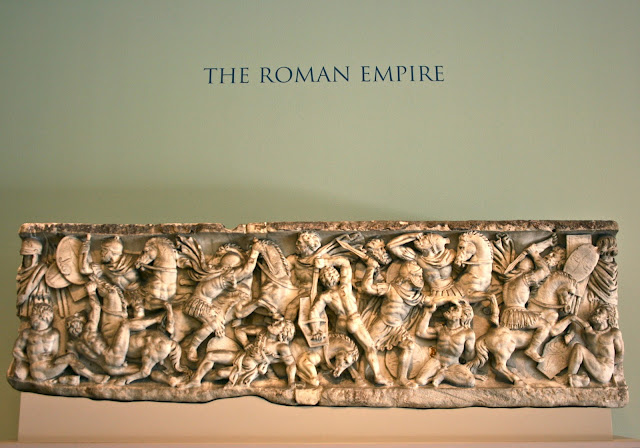We got there a little too early and had to wait 15 minutes before the doors opened. It took about 2.2 seconds for them to run full force to the giant red sculpture that in their eyes is a minimalist jungle gym I'm sure.
Believe it or not, the kids were not "posing" fore these pictures. They really were stopping and reading about the pieces and taking it all in.
Because I studied Art History for several years in University, the sections on Roman & Greek Art really intrigues me. It is one thing to see ancient objects and art in a book, and it is another to stand 12 inches away and see the detail and the wear from age.
This piece is AMAZING. I think it is a frieze from a sarcophagus, but I don't even know if I really read the information plaque, because I was too engrossed in the detail of the carving of the stone.
This picture gives you an idea of just how thick and hard this stone is.
But the carvers were able to capture so much detail in every area of the graphic scene. It tells a story, maybe a somewhat bloody one, but a battle for sure.
The paintings of Madonna & Child have always been favourites of mine. As a mother it really resonates with me the adoration in her eyes.
I also like the Italian Master's Paintings because most of them were allegorical stories or reincarnations of Greek Mythology.
As much as I would like to think my son is absorbing the story in this painting, I think after an hour of paintings and sculptures the kids were beginning to "zone" out. Off to go to the children's section, but passed a few more sculptures on the way....
 |
| PORTRAIT BUST OF THE EMPRESS MARIE LOUISE, 1810-1815 Baron Francois-Joseph Bosio, French, 1768-1845 Marble, Gift of Colonel C. Michael Paul |
 |
| PORTRAIT BUST OF CATHERINE, PRINCESS OF WURTEMBURG, 1810-1815 Baron Francois-Joseph Bosio, French 1768-1845 Marble, Gift of Colonel C. Michael Paul |
The Dallas Museum of Art has a great interactive kids space, with lots of interactive art. They also offer several classes and workshops here.
This was an interesting installation. It was a large "hole" in the wall, made of many different natural materials.
Next to this piece, is a wall with many pieces of paper and pencils, with the question written on the paper
"The words or pictures that come to mind when I look at this work of art are...."
There were some pretty creative, confusing and deep answers. This basically shows you how one work of art can be interpreted so many different ways!
After a few hours here, it was time to see another "point of view": The Zodiac Room at Neiman Marcus.
After lunch, we get on the escalators to go 6 floors down to the main floor. Much of the flagship store has its original fittings, such as the elevators and escalators and every wall seems to be its own gallery of art.
The glow and the shiny brass of the escalators walls makes this Neiman Marcus feel glamourous and historic.
But they always incorporate modern elements into the store, like this large glass sculpture, and a modernist vignette on another floor, below.
Ahhh, and the Bridal Boutique floor. How can you not stop here?
My friends daughter used her hands to make her own view finder. It was neat to see how the kid's minds were looking at things a little differently after our visit to the Museum.
I try to pass through the main floor with out stopping, but it is hard! But we must, because the troops are getting restless and I am scared one fling of my son's arms will bring down these mannequins like a set of feathered dominoes.
Yes, that was a wise decision to leave quickly, because once free of the "behave yourself" constraint I put on my child, he wasted NO time sliding down the banisters for a full 5 minutes.
WHAT A FUN DAY! I ENCOURAGE YOU TO TAKE A FRIEND AND YOUR KIDS, NO MATTER THEIR AGE, TO YOUR LOCAL ART MUSEUM.






































